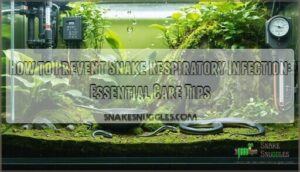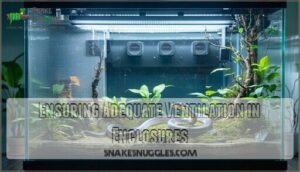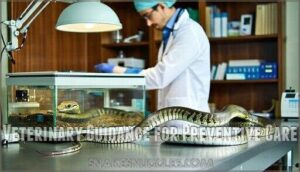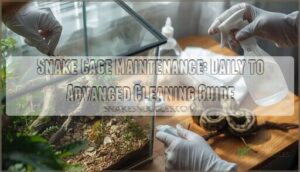This site is supported by our readers. We may earn a commission, at no cost to you, if you purchase through links.

You can’t wing it here – invest in quality thermometers and hygrometers. Verify adequate ventilation without creating drafts that’ll stress your snake.
Keep water fresh and habitat spotless through regular cleaning with reptile-safe disinfectants. Don’t overcrowd enclosures or mix species without proper quarantine protocols.
Watch for early warning signs like mouth breathing or wheezing during routine health checks. Think of prevention as insurance – a little effort upfront beats costly vet bills later.
The devil’s in the details regarding species-specific requirements, and it’s crucial to get them right to prevent respiratory infections, making prevention a key aspect of snake care, and considering it as a form of protection for your pet.
Table Of Contents
- Key Takeaways
- How to Prevent Snake Respiratory Infection?
- Maintaining Proper Temperature and Humidity Levels
- Ensuring Adequate Ventilation in Enclosures
- Providing Clean and Fresh Water
- Regular Cleaning and Disinfection of Habitat
- Monitoring Snake’s Environment and Health
- Avoiding Overcrowding and Stress
- Early Detection Through Health Check-ups
- Implementing Suitable Husbandry Practices
- Quarantine and Isolation Protocols
- Veterinary Guidance for Preventive Care
- Frequently Asked Questions (FAQs)
- Why does my snake keep getting respiratory infections?
- How to cure ball python respiratory infection?
- How to treat respiratory infections in reptiles?
- How can we prevent respiratory diseases in animals?
- How often should I clean my snakes habitat?
- What are the ideal temperature and humidity levels?
- How do I know if my snake is stressed?
- What are the early signs of respiratory infection?
- When should I seek veterinary guidance?
- What snake species require special respiratory care?
- Conclusion
Key Takeaways
- Nail your temperature and humidity basics – You need proper gradients (75-90°F) and species-specific humidity levels (40-80%) with quality monitoring equipment, not guesswork.
- Keep air moving without drafts – Set up cross-ventilation with mesh panels or vents on opposite sides to prevent stagnant air where bacteria thrive.
- Maintain spotless water and habitat – Change water daily, clean enclosures weekly with reptile-safe disinfectants, and do not let waste accumulate.
- Watch for early warning signs – Monitor for mouth breathing, wheezing, or nasal discharge during regular health checks, and get veterinary help immediately when symptoms appear.
How to Prevent Snake Respiratory Infection?
Since preventing snake respiratory infection starts with understanding your pet’s needs, you’ll want to focus on Infection Control and Biosecurity Measures.
Maintain proper temperature gradients between 75-90°F and humidity levels of 40-80% for ideal Respiratory Care. Verify adequate ventilation prevents stagnant air that breeds bacteria.
Provide fresh, clean water daily and monitor your snake’s hydration status. Regular snake health checks help you spot respiratory infection symptoms early, while proper Diet Management and careful Snake Handling strengthen natural immunity against respiratory disease prevention challenges.
Effective respiratory care tips are vital for maintaining your snake’s overall health and preventing infections.
Maintaining Proper Temperature and Humidity Levels
Temperature Control forms the backbone of respiratory health in snakes. You’ll need to establish thermal gradients that allow your snake to self-regulate its body temperature effectively. Set up heat sources to create warm zones of 85-90°F while maintaining cool areas between 75-80°F. Digital thermometers help you monitor these critical zones accurately.
Humidity Management works hand-in-hand with temperature regulation. Most species thrive with baseline humidity levels of 50-60%, though this varies by species. Ball pythons need 50-60% normally, increasing to 65-70% during shedding. Desert species require only 20-40%, while tropical snakes need 70-90%.
Humidity monitoring with digital hygrometers maintains consistent environmental conditions. Create humidity gradients by placing water bowls strategically and adjusting substrate moisture levels. Poor humidity control directly impacts respiratory health by stressing the immune system and making infections more likely.
Remember that temperature fluctuations below suitable ranges greatly increase infection risk. Consistent environmental management prevents costly health problems down the road. Understanding the temperature gradient is key for maintaining healthy snake conditions. Temperature Control remains vital for snake health.
Ensuring Adequate Ventilation in Enclosures
Adequate ventilation consistently protects your snake from respiratory infections by maintaining ideal air quality.
Proper airflow prevents deadly bacteria buildup in your snake’s enclosure.
Poor air circulation creates stagnant conditions where harmful bacteria thrive, putting your pet at serious risk.
Key Facts to Consider
Air flow and ventilation systems work together to create the breathing space your snake needs. Cross-ventilation remains the gold standard – fresh air enters one side while stale air exits the opposite side. This strategic ventilation method prevents dangerous oxygen level drops that stress your snake’s respiratory system. Proper ventilation is essential for maintaining good air quality control in reptile enclosures.
Consider these essential ventilation methods for your enclosure design:
- Mesh panels positioned on opposite walls create natural air circulation patterns
- Multiple vents prevent stagnant air pockets in corners where bacteria accumulate
- Screen tops balance security with adequate airflow for proper airflow importance
Strategic placement matters more than size. Your enclosure sizing should include ventilation holes smaller than your snake’s body diameter to prevent escapes while maintaining circulation.
Providing Clean and Fresh Water
Proper ventilation sets the stage for another key health factor. Water quality plays a critical role in preventing respiratory infections by supporting your snake’s immune system and maintaining healthy mucus membranes.
Fresh supply requirements are straightforward. Change your snake’s water daily using chlorine-free sources. Dehydration thickens mucus, creating perfect conditions for respiratory problems to develop. Clean bowls prevent bacterial contamination that can compromise your pet’s health.
Water change procedures should include thorough bowl cleaning with reptile-safe disinfectants. Position water dishes away from substrate and waste areas to maintain water sanitation.
Hydration tips include monitoring your snake’s drinking habits and watching for signs of dehydration like wrinkled skin. Proper hydration supports natural defenses against infection.
Some species benefit from light misting to increase humidity, but avoid soaking substrate. Clean environment tips include using ceramic or glass bowls that resist bacteria buildup.
- Monitor water temperature to match your snake’s comfort zone – extreme temperatures stress their system
Fresh water availability remains non-negotiable for respiratory health. Maintaining a clean habitat involves understanding reptile care basics to prevent infections.
Regular Cleaning and Disinfection of Habitat
Clean water sets the foundation, but habitat sanitization keeps your snake healthy long-term.
Substrate replacement should happen weekly, removing all bedding and waste completely. Disinfection methods using reptile-safe cleaners prevent bacterial buildup on surfaces.
Your cleaning checklist must include water bowls, hides, and decorations. Cleaning schedules work best when you spot-clean immediately after messes occur.
Biosecurity measures like washing hands between tasks stop cross-contamination. Proper enclosure hygiene means thorough residue removal after using reptile-safe disinfectants.
Maintaining a snake habitat is essential for preventing respiratory infections in snakes.
Monitoring Snake’s Environment and Health
Beyond keeping your habitat spotless, you need to watch your snake like a hawk. Regular monitoring catches problems before they snowball into serious respiratory health issues. Your snake can’t tell you when something’s wrong, so you become their voice.
Environmental Checks should happen daily:
- Monitor humidity control levels with reliable hygrometers
- Check temperature gradients throughout the enclosure
- Assess Air Quality and ventilation effectiveness
- Observe Snake Behavior patterns during feeding and activity
- Document Health Signs like breathing patterns and appetite changes
Smart Hygiene Practices and biosecurity measures protect your pet’s respiratory health. Track eating habits, movement patterns, and overall energy levels. Snake enclosure cleaning records help identify environmental triggers. Proper ventilation prevents stagnant air that breeds bacteria.
Maintaining ideal snake health requires understanding snake health basics.
Avoiding Overcrowding and Stress
Creating a stress-free environment protects your snake’s respiratory health and strengthens natural defenses.
Overcrowding weakens immune systems and increases infection risk through poor air quality and territorial disputes.
- Enclosure Size: Provide minimum one-third of snake’s body length for proper movement
- Animal Separation: House snakes individually since most species are naturally solitary
- Population Control: Never cohouse multiple snakes to prevent territorial stress
- Stress Reduction: Minimize handling during feeding periods and seasonal changes
- Ventilation: Maintain airflow without drafts to prevent stagnant air buildup
- Humidity Control: Monitor levels consistently to avoid respiratory complications
Proper reptile environment design is essential for maintaining a healthy and thriving snake.
Early Detection Through Health Check-ups
Through regular health checks, you’ll catch problems before they become serious.
Schedule routine visits with a reptile veterinarian who understands snake signals and can perform thorough examinations. These professionals use diagnostic tests like fecal exams to identify hidden issues affecting respiratory health.
During appointments, they’ll assess breathing patterns, check for respiratory symptoms, and evaluate overall condition. Early detection saves money and prevents suffering.
Between visits, monitor your snake’s behavior daily. Watch for subtle changes in appetite, activity, or breathing.
Professional veterinary care provides expertise you can’t replace with home observations alone. Regular monitoring acts as your safety net, ensuring small problems don’t escalate into life-threatening conditions.
Maintaining a snake health checklist is essential for identifying potential issues early on.
Implementing Suitable Husbandry Practices
Master proper husbandry practices to shield your snake from respiratory infections through strategic habitat management. Your approach should focus on three core areas that directly impact respiratory health.
Substrate Management forms your first line of defense. Choose moisture-retaining substrates like coconut fiber or cypress mulch that support humidity control without creating bacterial breeding grounds. Replace substrate weekly and maintain proper enclosure hygiene through spot-cleaning protocols.
Environmental Enrichment paired with nutrition planning strengthens your snake’s immune defenses. Here’s your action plan:
- Temperature monitoring systems with digital thermometers in warm (85-90°F) and cool (75-80°F) zones
- Ventilation systems that prevent stagnant air while maintaining species-appropriate humidity levels
- Snake handling protocols that minimize stress during routine maintenance and health assessments.
Biosecurity measures complete your prevention strategy. Wash hands between enclosure maintenance tasks and use dedicated tools for each habitat. This systematic approach creates an environment where respiratory infections can’t gain a foothold. Effective snake health practices are essential for preventing respiratory infections in snakes.
Quarantine and Isolation Protocols
Quarantine protocols protect your entire snake collection from disease spread.
Separate Enclosures house new arrivals for 60-90 days away from established pets.
This Quarantine Duration allows hidden infections to surface before New Snake Introductions occur.
Biosecurity Measures include washing hands between handling different animals and using dedicated tools for each enclosure.
Isolation Techniques prevent airborne transmission through proper room separation.
Bioexclusion means keeping quarantined snakes completely isolated from your main collection.
These Isolation Protocols act as your first defense against respiratory infections entering your snake room.
Effective quarantine procedures involve understanding snake health guidelines to minimize disease risk.
Veterinary Guidance for Preventive Care
Professional veterinary guidance forms the cornerstone of effective snake health monitoring and respiratory infection prevention.
Your reptile veterinarian provides essential diagnostic tests and preventative measures customized to your snake’s specific needs.
- Peace of Mind: Regular health checks catch problems before they become serious threats
- Expert Knowledge: Veterinary advice guarantees you’re following the latest snake nutrition and care protocols
- Early Detection: Professional monitoring identifies subtle signs you might miss at home
Establishing a relationship with an experienced reptile veterinarian isn’t just smart—it’s essential for your snake’s long-term health and your confidence as an owner.
Regular health assessments and preventative health care for pet snakes, including reptile health checks, are fundamental for maintaining your snake’s overall well-being.
Frequently Asked Questions (FAQs)
Why does my snake keep getting respiratory infections?
Like a broken thermostat wreaking havoc, your snake’s recurring respiratory infections likely stem from improper temperature gradients, humidity imbalances, poor ventilation, or stress from suboptimal husbandry practices.
How to cure ball python respiratory infection?
See a reptile vet immediately for antibiotics like enrofloxacin. Meanwhile, raise temperatures to 88-92°F, increase humidity to 60-70%, and make certain proper ventilation to support recovery.
How to treat respiratory infections in reptiles?
Treat reptile respiratory infections with veterinary-prescribed antibiotics like enrofloxacin. Maintain proper temperature gradients, humidity levels, and clean enclosures. Provide supportive care including nebulization therapy and guarantee adequate hydration throughout recovery.
How can we prevent respiratory diseases in animals?
Many people think prevention’s complicated, but it’s straightforward. Maintain proper temperature gradients, humidity levels, and ventilation. Provide clean water, balanced nutrition, and stress-free environments. Regular health monitoring catches problems early.
How often should I clean my snakes habitat?
Clean your snake’s habitat weekly by replacing all substrate and waste. Spot-clean messes immediately. Monthly deep cleaning with reptile-safe disinfectant keeps bacteria at bay. Fresh water daily prevents respiratory problems.
What are the ideal temperature and humidity levels?
Keep your snake’s warm side at 85-90°F and cool side around 75-80°F. Maintain humidity between 50-70% depending on species. Use reliable thermometers and hygrometers to monitor levels consistently.
How do I know if my snake is stressed?
Your snake’s comfort zone isn’t always obvious.
Watch for excessive hiding, restlessness, refusing food, irregular shedding, defensive posturing, or changes in normal behavior patterns.
These signals mean it’s time to check your husbandry basics, as they can indicate issues that need attention, such as problems with temperature.
What are the early signs of respiratory infection?
Watch for wheezing sounds, open-mouth breathing, nasal discharge, or excessive mucus around the mouth. You’ll also notice decreased appetite, lethargy, and your snake becoming less active than usual.
When should I seek veterinary guidance?
Seek veterinary help immediately when you notice open-mouth breathing, wheezing sounds, nasal discharge, or appetite loss. Don’t wait—respiratory infections worsen quickly without professional treatment.
What snake species require special respiratory care?
Like caring for a delicate orchid, certain species need extra attention.
Boids, including boas and pythons, face higher respiratory risks due to their size and sedentary nature, requiring stricter temperature and humidity control, which is crucial for their well-being, especially in terms of respiratory health.
Conclusion
Studies show respiratory infections affect nearly 30% of captive snakes annually.
Learning how to prevent snake respiratory infection requires consistent attention to environmental basics. You’ll need proper temperature gradients, humidity control, and ventilation without drafts.
Keep water fresh and enclosures clean with reptile-safe disinfectants. Watch for early warning signs like mouth breathing during regular health checks.
Don’t overcrowd habitats or skip quarantine protocols. Prevention beats treatment every time, and following these guidelines is key to maintaining the health of your snakes through proper care.
- https://familysnake.com/guides/breathe-easy-preventing-respiratory-infections-in-your-pet-snake/
- https://www.vetexotic.theclinics.com/article/S1094-9194(21)00003-7/fulltext
- https://lafeber.com/vet/respiratory-disease-in-snakes/
- https://pubmed.ncbi.nlm.nih.gov/33892890/
- https://www.sciencedirect.com/science/article/abs/pii/S1094919417300865














